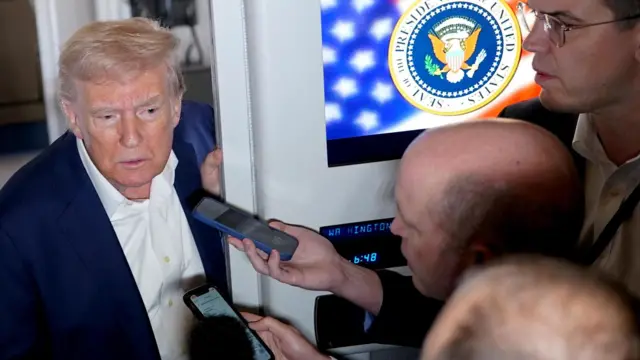Recent US Tariff Measures on China
The Trump administration has taken several steps to modify tariffs on Chinese goods, signaling a continued focus on trade policy as a central aspect of its economic strategy. White House economic advisers have taken a firm stance, noting that there are no plans for tariff exemptions on a range of products.
In contrast to earlier positions, China has responded by increasing duties on American imports, which suggests a hardening stance in trade negotiations. This rise in duties has affected a wide range of products, with China raising the import tax from 84% to a significant 125%. The back-and-forth between the two countries marks an ongoing tension that has not found resolution through recent talks.

A temporary exemption that had previously been in place for certain electronics, such as smartphones and laptops, was issued by the Trump administration. This initiative appeared to be an attempt to alleviate some of the pressure from tariffs on American businesses and consumers. However, with the threat of new chip levies, there is an additional layer of complexity in the broader context of these trade actions.
While economic advisers within the administration allude to potential advances in trade discussions, it is evident that the current trade war presents challenges with no clear winners. The administration is moving toward implementing new tariffs, which include the possibility of opening an investigation, further escalating the situation.
The implications of these measures are far-reaching, raising concerns about global economic stability and the impact on the cost of consumer goods. The Trump administration’s tactics reflect an aggressive approach to addressing trade imbalances, but they also risk prolonging the trade conflict.
Impact of Donald Trump’s Trade Levies on the Global Economy
Donald Trump’s trade policies, particularly the imposition of tariffs, have significantly shifted the dynamics of global trade. The introduction of higher tariffs on goods from other nations, notably China, prompted a chain reaction impacting economies worldwide.
Stock Markets Reaction: Financial markets have experienced volatility, with indexes like the S&P/TSX often reacting to tariff announcements. For instance, in early trading sessions, they were observed to surge over 200 points.
Consumer Prices: In the United States, the costs of certain goods have escalated due to tariffs, as companies pass on the higher expenses to consumers.
Retaliatory Tariffs: Other nations, such as China, have retaliated with their own tariffs on American products, leading to increased prices for consumers and challenges for exporters.
Trade Negotiations: These tariffs have acted as a catalyst for trade negotiations, prompting countries to revisit and renegotiate trade agreements.
Global Supply Chains: There has been a disruption in global supply chains, as businesses seek to navigate and adapt to the changing tariff landscapes to minimize costs.
It’s important to note that while some industries may benefit from protective tariffs, which help to shield them from overseas competition, the overall effect of this trade policy can create economic uncertainty and hinder global economic growth.
International Reactions to United States Trade Tariffs

In recent events, various countries have responded to the United States’ new trade tariffs. The Trump administration’s decision to impose additional tariffs has received notable reactions from trade partners across the globe.
China, one of the major trade partners impacted by these tariffs, has retaliated by increasing its own duties on U.S. imports, creating a significant rise from the previous rates. According to reporting by Yahoo Finance, the rates were pushed up to 125% in response to the U.S. tariffs. This marks a substantial escalation in the ongoing trade tensions between the two economic powerhouses.
In addition to China, other countries and economic groups have taken steps to address the situation. While some have entered into negotiations to seek exemptions or adjustments to these tariffs, others have considered or implemented reciprocal tariffs on American goods. For instance, as reported by CNBC, the White House’s strategy appears to be focused on isolating China by reducing tariffs for other trade partners temporarily, while significantly increasing tariffs on Chinese goods.
Furthermore, the European Union, Canada, and Mexico are among those that have voiced concerns and, in some cases, taken countermeasures. These actions signal a complex and multi-fronted response to U.S. trade policy, which has affected various industries, including agriculture, manufacturing, and technology sectors.
The tariffs have prompted a range of strategic responses, from legal challenges in international courts to seeking alliances that may bypass or minimize dependence on U.S. trade. They have also stirred discussions on the long-term implications for international trade relations and the global economy.
Impact of Tariffs on US Industry Sectors

The tariffs put in place by Donald Trump have most significantly impacted certain sectors within the United States economy. Key areas that have felt the effects include:
- Technology and Consumer Electronics: This sector has experienced rising costs, with products such as mobile phones and computers seeing price increases. This is due in part to tariffs on imported parts and finished goods from countries that are key suppliers of tech products. For more information, visit Trump team sows confusion over electronics tariffs as chip levies loom.
- Agriculture: American farmers, especially those producing soybeans and pork, have been affected due to retaliatory tariffs from trading partners. Exports have decreased, leading to a surplus within the domestic market and falling prices.
- Manufacturing: The cost of raw materials, especially steel and aluminum, has gone up, affecting the bottom line for manufacturers of products ranging from automobiles to appliances.
- Retail: Retailers that depend on imported goods have faced higher costs, potentially leading to higher prices for consumers. Delicate supply chains have also been disrupted, affecting inventory and operations.
These sectors represent a snapshot of the broader economic landscape dealing with the consequences of Trump-era tariffs.
Reasons Behind the Trump Administration’s New Tariff Measures
The Trump administration has been very straightforward regarding its decision to implement new tariffs. The main argument is to safeguard American economic interests and maintain its competitive edge in the global market. The administration has identified foreign trade practices that seem unfair and pose a risk to the US economy as the primary reason for these measures.
For instance, he has signaled intentions to target powerful computer chips used in smartphones and other technologies through tariffs, aiming to encourage local production. Additionally, the administration is concerned about intellectual property theft and the US’s massive trade deficit with other countries.
Key Points Outlined by President Trump:
- Protecting Domestic Jobs: Tariffs aim to protect American workers and their jobs by making foreign goods more expensive compared to locally-produced items.
- Responding to Unfair Trade Practices: Tariffs are a response to what the US sees as unfair trade and economic practices by other nations.
- Reducing Trade Deficits: Addressing the trade deficit by making imports more expensive, which should help reduce the quantity of goods brought from abroad.
Furthermore, the administration maintains that these tariffs are in place to protect national security and US intellectual property. The belief is that by teetering on the side of protectionism, the US can regain leverage in international trade negotiations.
Confusion Amidst Tariff Updates: Recent reports highlight some inconsistencies and confusion regarding tariff exemptions, especially concerning high-tech products from China. A Trump official emphasized that any exemptions should be seen as temporary.






































